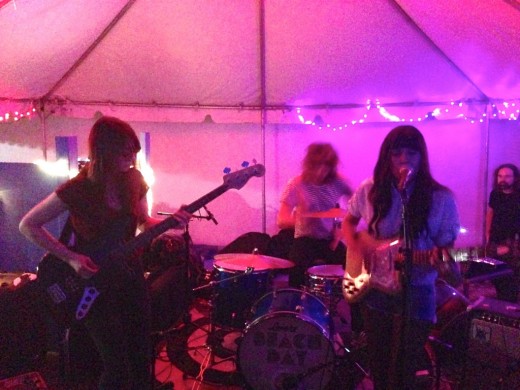Walkin’ in the Sand with Beach Day
Jeremy Adams

Photo by Kimmy Drake.
Today, I’m sitting across from Drake (taller and stronger in person) and drummer Skyler Black just outside the peaceful, white-walled, charmingly retro Danish Pastry Company in the band’s home base of Hollywood, Florida. Drake’s in jeans, a horizontal-striped top, and shades while Black sports a long-sleeve sweater and trucker hat. We’re talking relaxedly about the pros and cons of East Coast versus West Coast grocery store chains. By any measure, it’s a stark contrast from the night the duo, alongside their touring bassist, cut through the chaos outside Gramps with blasts of retro-pop, surf-style melodies and grrrl-punk vocals, all encased within sentimental song titles like “Boys,” “Come Back to Me,” and “Am I the Only One.”
“We were just, like, having fun!” the pair declare, almost in unison. Regarding the throwback sounds the band crafted on Trip Trap Attack, its debut album released last summer through Brooklyn-based Kanine Records, Drake explains, “We weren’t even thinking about what we’re doing with this. We just really wanted to do it.” Yet the simplicity and innocence of Beach Day’s music comes off as refreshing, especially in an era dominated by glossy, overproduced radio hits and computerized EDM chirps. It’s also more complicated than it might seem. Take the first tune Drake wrote, also called “Beach Day,” which begins with a “Wipe Out”-style drum intro and patterned guitar strums, then ’60s organ and handclaps, then an explosion of full-out vocal harmony exhorting the listener to “run away.” The song’s reminiscent of pioneering girl group the Shangri-Las—known mostly for their hits “Leader of the Pack” and “Remember (Walkin’ in the Sand)”—but also more recent, edgier nostalgia acts like Vivian Girls and Best Coast. “Just escapism,” Drake grins playfully.
For the twenty-something Drake, who attended the Art Institute of Fort Lauderdale and designs the band’s album covers, escapism used to involve weekly trips to Key Biscayne’s Crandon Park Beach with her surfer/scuba-diving-instructor/underwater-photographer dad and stay-at-home mom, both of whom encouraged her to pursue music. “I started singing in elementary school,” she recalls. “I was in the choir, so I did all the Christmas pageants, etc. I got my first guitar when I was eight or nine, I’m not sure. I took piano lessons for a little while, but my teacher was super-mean, so I quit.” In these moments, Drake shows a mix of girlishness and sharp confidence, sharing goofy stories of her misadventures with an amplifier in high school while also stating calmly that she feels like she “just already knew” she wanted to be an artist from a very young age.

Beach Day performing at Gramp’s, December 13th, 2013. Photo: Mark Little.
Black eventually honed his skills, of course, and while on tour in South Florida with his previous band the Black Rabbits, he spotted Drake wailing on the guitar as frontwoman for her own indie-grunge outfit. “I started freaking out!” he exclaims. “I’m, like, whoa! This girl is killing it. And so I ran outside and started telling everybody to come in.” Black recruited her to play organ and percussion for the Rabbits, and the duo bonded over a mutual love of surf music during rehearsals in North Carolina, where he attended college. “I’ve always had a thing for surf drums, like the Ventures,” Black explains. “I just thought it was so fun and so catchy.” Echoes Drake: “I love surf guitar. That’s just something I love to play. It’s one of my favorite things to do.” The pair eloped from North Carolina—not literally; in fact, they insist they’re “not a couple,” although they do share an apartment—formed Beach Day, and the rest is sunny history.
With their second album Native Echoes newly released on August 19th, the band sees its potential as larger than just the Miami or Florida music scenes. “Our goal has never been local,” asserts Drake. The group will play the West Coast later this summer, and a European tour is in the works for the fall. Like fellow indie-pop acts Cults and Tennis, they plan to remain a two-piece, with the addition of a performing bassist for live shows. Regarding the record, it features more diverse instrumentation than Trip Trap Attack, with synths, noise, and even ambient nature sounds sneaking their way onto multiple tracks, but offers the same catchy, edgy production from garage-rock guru Jim Diamond (the White Stripes, the Dirtbombs) as well as a slew of sing-along choruses. First single “Don’t Call Me on the Phone” is one of the sweetest-sounding kiss-offs in recent memory, and hypnotic lo-fi anthem “The Lucky One” will likely be heard blaring from the stereos of many a convertible over the months to come.
Back at the Danish Pastry Company in Hollywood, however, the young musicians strike a reflective tone. “I feel like over the last two years, we’ve learned so much. I feel like we just know so much more than we did,” says Drake coolly, wrapping both hands around her mug of coffee. “‘No’ has never been a thing we say,” adds Black. “Say ‘yes’ to everything, let’s get out of here, let’s go. We may not have the money right now, but let’s do it anyway. And then somehow it happens. It’s weird, right?” Weird or not, Beach Day is riding the waves towards rock glory.










